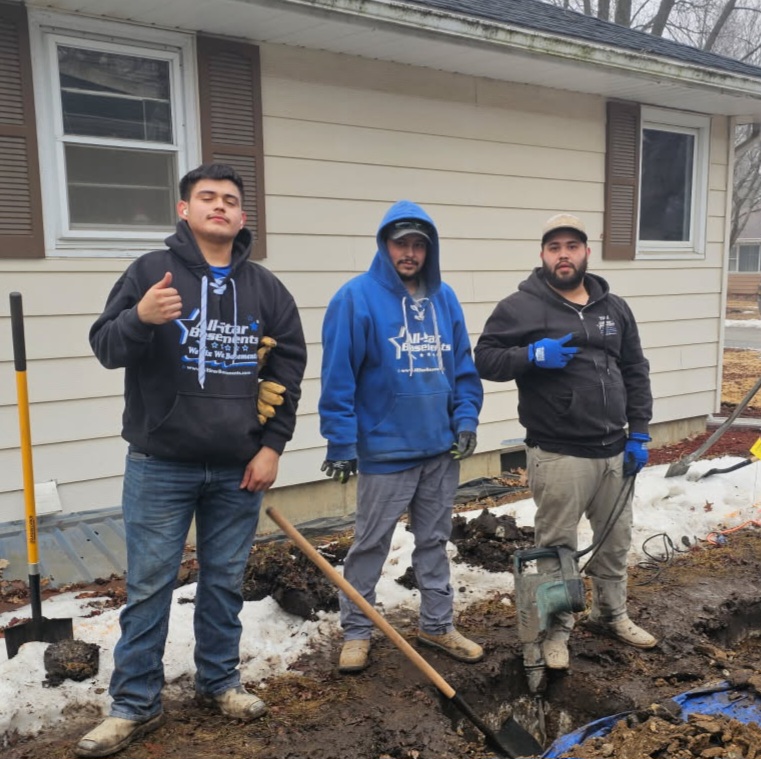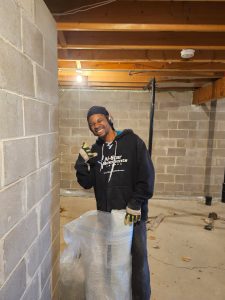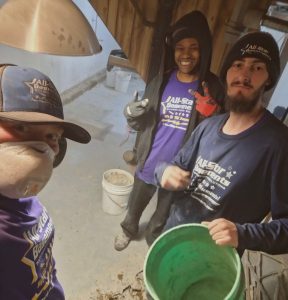
You might not give it much thought, but your basement’s waterproofing condition plays a key role in your home’s safety and overall value. Regular inspections can catch early signs of trouble, like dampness or mold, which could lead to costly structural damage if ignored. But did you know that a well-maintained waterproofing system can also increase your home’s value? Now, you’re probably wondering, “How do I guarantee my basement is properly waterproofed?” Let’s unpack this together.
Understanding Basement Waterproofing
Delving into the world of basement waterproofing, it’s essential to grasp its basics. This process involves techniques and materials used to prevent water from penetrating your basement. It’s a necessary step in ensuring your basement remains dry, safe, and useable.
 Water damage can cause serious issues in your home. You’re likely to experience structural problems, mold and mildew growth, or even foundation issues. Waterproofing combats these potential headaches by creating a barrier that stops water from seeping in.
Water damage can cause serious issues in your home. You’re likely to experience structural problems, mold and mildew growth, or even foundation issues. Waterproofing combats these potential headaches by creating a barrier that stops water from seeping in.
Several methods can be used to waterproof your basement. The first, and most common, is the interior method, which involves applying sealant materials, installing sump pumps, and constructing drainage systems. It’s a relatively affordable option and can be highly effective.
Exterior waterproofing, on the other hand, is more intensive and expensive but offers more thorough protection. This method involves excavating around the house to install a waterproof membrane on the foundation walls, combined with a drainage system.
Lastly, there’s the drainage method, which can be either interior or exterior. This involves installing a drainage system to control water levels around your basement.
Understanding these methods is key to determining what your home needs. A professional can guide you through this decision-making process, ensuring you choose the best option.
The Importance of Regular Inspections
Don’t underestimate the importance of regular inspections for basement waterproofing.
They’re essential not only for preventing structural damages that could result from unchecked water seepage, but also for maintaining your home’s overall value.
Preventing Structural Damages
Regularly conducting thorough inspections of your basement is essential to prevent structural damages.
It’s not just about keeping your basement dry, but also about ensuring the overall stability of your home. Over time, excessive moisture can lead to a host of problems, including wood rot, mold growth, and foundation cracks.
These issues aren’t just annoying; they’re potentially devastating to your home’s structural integrity. Wood rot weakens the support beams, while mold can eat away at the walls and flooring.
More concerning, foundation cracks can lead to serious complications if not addressed timely. They can widen, causing your house to shift, which may result in uneven floors, cracked walls, and even a collapsed roof.
But don’t fret, a waterproofing inspection can help you catch these problems early on.
Maintaining Home’s Value
How often have you considered the impact of your home’s condition on its market value? It’s a factor that’s often overlooked but is incredibly important.
Regular basement waterproofing inspections are a key element in maintaining and even boosting your home’s value. Each inspection serves as a protective measure, identifying potential issues before they escalate into costly repairs.
Water damage, mold growth, and structural problems can all greatly decrease your property’s worth. By regularly inspecting and addressing these issues proactively, you’re preserving the integrity of your home and protecting your investment.
Moreover, if you ever decide to sell, potential buyers will likely be conducting their own home inspection. A well-maintained, waterproofed basement can be a major selling point, reassuring buyers that they won’t be faced with unexpected repair costs and demonstrating that you’ve taken good care of your home.
Early Signs of Basement Water Issues
To safeguard your home from potential water damage, it’s crucial to be aware of the early signs of basement water issues. Water intrusion can be sneaky; it often starts subtly and worsens over time. So, identifying signs early can save you from hefty repair costs in the future.
One of the first indicators of water issues is a damp, musty odor emanating from your basement. This smell is a clear sign of moisture build-up. If you spot wet spots or water stains on walls, ceilings, or floors, it’s time to take action.
Peeling paint or wallpaper, and efflorescence – a white, chalky substance on your basement walls or floors – also point to moisture problems.
Another sign to look out for is mold growth. Mold thrives in damp environments and can cause serious health issues.
Finally, observe the exterior of your home. If you see water pooling close to your foundation or notice your gutters aren’t directing water away from your home, these could be warning signs.
Stay vigilant for these early indicators, and you’ll be one step ahead of any water damage. It’s your home, protect it wisely.
Consequences of Neglected Basement Waterproofing
Overlooking basement waterproofing can lead to significant consequences.
You might expose your home to risks of structural damage, which can compromise the safety and integrity of your property.
Health hazards due to mold and mildew growth, along with escalating repair costs, can further complicate the situation.
Structural Damage Risks
Water damage, a silent destroyer, can pose severe structural risks to your home if basement waterproofing is neglected. This insidious problem often starts unnoticed, slowly eroding the stability of your home’s foundation.
Over time, the relentless seepage of water can weaken the structural integrity of your home, causing cracks, buckling walls, or even foundation collapse.
Neglected waterproofing can also lead to dampness in your basement. This persistent moisture can cause wood rot in any wooden structures within or attached to your basement. This isn’t merely an aesthetic issue; it’s a structural one.
Rot can cause beams, floor joists, and other critical structures to fail, threatening the safety and stability of your home.
Moreover, the pressure from accumulated ground water around your home’s foundation can trigger a phenomenon known as hydrostatic pressure. This can result in significant foundation damage, leading to costly repairs.
Don’t underestimate the power of water. It’s a silent, slow, but relentless enemy that can wreak havoc on your home’s structure if given the chance.
Ensuring a dry, properly waterproofed basement is a critical step in safeguarding your home against these potentially devastating structural damage risks.
Health Hazards Unveiled
In a neglected, damp basement, a silent health menace thrives. You mightn’t be aware, but lurking in the shadows of your basement is a potential health hazard: mold. This insidious growth thrives in damp conditions, multiplying rapidly and releasing spores that can have serious health effects.
Exposure to these mold spores can cause a range of health problems, from allergic reactions and asthma attacks to more serious conditions like chronic sinusitis and lung infections. If you’ve got seniors or kids at home, they’re at higher risk. Even your pets aren’t safe from the effects of mold exposure.
Remember, you can’t just scrub away mold. It’s a symptom of a larger problem – excess moisture. Without proper waterproofing, your basement will continue to be a breeding ground for these health hazards.
It’s not just about maintaining your home’s structural integrity, it’s about safeguarding your family’s health.
Don’t wait for the health effects to manifest. If your basement hasn’t been waterproofed, or if it’s been a while since your last inspection, it’s time to act. An ounce of prevention, in this case, is far better than a pound of cure.
Escalating Repair Costs
Neglecting basement waterproofing can lead to staggering repair costs down the line. The initial signs of water damage might seem minor, but don’t be fooled. They’re a red flag warning you of the financial storm brewing beneath your home.
If you ignore these early signs, you’re allowing the problem to grow. As the water damage spreads, it weakens your home’s structure. It’s not just the basement floor and walls at risk. The foundation itself can become compromised.
Do you know the cost of foundation repairs? They’re not cheap. A simple crack repair can run into thousands of dollars, and that’s just the start.
Further neglect leads to mold growth, which requires professional removal. Left unchecked, mold can invade your entire home, affecting the air quality and resulting in health issues for your family.
The cost to remediate this? It can be astronomical.
Impact on Home’s Structural Integrity
Compromising your home’s structural integrity can be a disastrous consequence of an inadequately waterproofed basement. Over time, continuous exposure to moisture can cause the foundation walls and floors to weaken, leading to cracks, bulges, or even a complete collapse.
This isn’t just a cosmetic issue; it’s a serious safety concern that can put you and your family at risk.
Now, you may wonder how water can cause such significant damage. Water seeping into your basement can erode the soil surrounding your foundation, causing it to shift and crack. This can lead to uneven floors, warped walls, and a destabilized house frame.
Furthermore, constant dampness can cause the wooden elements in your structure to rot, further undermining your home’s stability.
Here’s where a professional basement waterproofing inspection comes in. By identifying and addressing potential water issues early on, you’re not just preventing water damage; you’re preserving the structural integrity of your home.
The Role of Waterproofing in Mold Prevention
Did you know that waterproofing your basement can play an important role in mold prevention? Moisture is mold’s best friend, providing the perfect conditions for its growth. When your basement isn’t waterproofed, it becomes a high-risk area for mold development, especially if it’s prone to flooding or dampness.
Waterproofing fundamentally creates a barrier that restricts water from seeping into your basement. This process markedly reduces the moisture level, making it a hostile environment for mold.
It’s not just about keeping your basement dry; it’s about ensuring your home is healthy and safe.
Mold can lead to serious health issues, including allergies, asthma, and other respiratory problems. In particular, black mold is highly toxic and can cause severe health problems if not addressed promptly.
As a result, waterproofing isn’t just a preventative measure for protecting your home’s structure; it’s a vital step in safeguarding your family’s health.
Costs of Ignoring Basement Waterproofing
While waterproofing your basement plays a significant role in preventing mold and safeguarding your family’s health, it’s equally important to understand the costs associated with ignoring this essential home improvement task.
You might think you’re saving money by not investing in waterproofing, but the truth is, the costs of neglect can far outweigh the initial outlay.
Ignoring waterproofing can lead to moisture seepage, which in turn can cause extensive damage to your home’s structure. This can lead to significant repair costs down the line.
Additionally, persistent dampness creates an ideal environment for mold growth. You’ll then be faced with the high costs of mold remediation, and possibly medical bills if any family members develop health issues related to mold exposure.
Furthermore, if you ever decide to sell your home, a damp basement can seriously decrease its value. Potential buyers are likely to demand a reduced price or even walk away altogether.
In short, the cost of ignoring basement waterproofing can be steep. It’s far more economical to invest in waterproofing early on, saving you money and potentially serious headaches in the long run.
Professional Inspection Versus DIY Checks
Choosing between a professional inspection and conducting a DIY check for your basement waterproofing needs can be a tough decision.
It’s essential to weigh the pros and cons of both options.
With a professional inspection, you’re getting the expertise and knowledge of a trained professional. Their experience allows them to spot issues you might miss.
They’ll also have specialized equipment, which mightn’t be accessible to you. In addition, a professional can provide you with a detailed report, making it easier for you to take necessary steps for repair or maintenance.
On the other hand, DIY checks can be cost-effective. You’re not incurring the expense of a professional, and you can do them at your convenience.
However, they may not be as thorough. Without the trained eye of a professional, you might overlook key signs of damage or potential problems.
Choosing a Reliable Waterproofing Inspector
Steering through the sea of waterproofing inspectors might seem intimidating, but it doesn’t have to be.
 First, prioritize a licensed, insured, and bonded inspector. It’s your assurance they’re certified to handle water-related issues and damages won’t be at your expense.
First, prioritize a licensed, insured, and bonded inspector. It’s your assurance they’re certified to handle water-related issues and damages won’t be at your expense.
Check their experience. Inspectors who’ve been in the game longer are likely to be more knowledgeable and skilled, capable of identifying and dealing with complex issues.
Ask for references and check online reviews. Customers’ feedback can offer insights into their expertise and reliability.
Ensure they specialize in residential waterproofing. Industrial and residential waterproofing are different ball games. You want someone who knows the home terrain.
Look for inspectors who offer a thorough inspection. They should examine not just the basement but also the exterior of your home, the drainage, and the foundational structure.
Finally, consider their proposed solutions. Beware of those who push for expensive, invasive solutions right off the bat.
Professionals will first recommend simpler, less costly remediations.
Next Steps After a Waterproofing Inspection
Having navigated the process of selecting and hiring a waterproofing inspector, it’s time to focus on what comes next. Post-inspection, you’ll receive a detailed report outlining the state of your basement’s waterproofing. It’s important you don’t ignore this document; it contains invaluable information about your property’s condition.
Firstly, review the inspector’s findings meticulously. They’ll highlight any existing or potential water damage, cracks, or leaks. Understanding these problems is vital in determining the next steps. If there are minor issues, you may consider DIY fixes. However, for major concerns, professional intervention becomes necessary.
Next, get a quote for the required work. Don’t rush into the first offer. Compare estimates from different contractors to guarantee you’re getting a fair deal. Also, ask for a detailed breakdown of costs to truly understand what you’re paying for.
Finally, schedule the repairs. Prioritize urgent issues to prevent further damage. Remember, delays could exacerbate the problem, leading to more extensive repairs and higher costs.
Following your waterproofing inspection, it’s your responsibility to act on the findings. By doing so, you’re safeguarding your home from potential damages and maintaining a safe, dry living environment. This proactive approach will also save you time and money in the long run.
Don’t let your home fall prey to the destructive power of water. Visualize a mold-free, dry basement, adding value to your property and peace to your mind. Regular waterproofing inspections are the key to this vision. By identifying potential threats early, you can save money and avoid catastrophic damage. Choose a reliable inspector, stay proactive, and keep your home a safe haven. Remember, prevention is always better, and usually cheaper, than cure.

All-Star Basements is Locally Owned and Operated and based out of Rochester, Minnesota. We cover Southern Minnesota including the Twin Cities area, Western Wisconsin and parts of Northeast Iowa. Our team is committed to solving our customers’ basement waterproofing, foundation repair, or crawl space needs and offering multiple solutions to choose from.
As a proud member of the Basement Health Association and the National Waterproof Members of America, we have the best products available to solve your leaky basement, seepage, or flooding issues. Our lineup also includes multiple crawl space solutions.
If you have foundation problems that need any kind of repair, we can help! We feature the nationally renowned Grip-Tite Foundation Systems, which has a long history over 90 years of fixing homeowners’ foundation repair issues- from walls that are buckled, tipping or cracked and bowing.
At All-Star Basements, we are committed to providing multiple solutions to choose from to help fix any basement problem you may have. We are very proud of our Better Business Bureau A+ rating and take great pride in caring for all of our customers’ needs- big or small, we do it all!